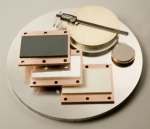APPLICATIONS
Sputter Target Bonding
S-Bond® active solders enable the joining of dissimilar metals and ceramics to each other and to other metals. S-Bond filler metal alloys produce reliable joints with copper, aluminum, steel, stainless steels, titanium, chromium, nickel alloys, refractory metal alloys and many ceramics including alumina, zirconia, AlN and SiC. S-Bond also joins to most semiconductors including Si, GaAs, CIGS, etc.
S-Bond joins…
- Directly, without the use of flux.
- Without pre-plating steps, eliminating multiple step coating processes.
- At temperatures below 400ºC, preventing the distortion and softening of metals and preventing ceramic fractures.
The joints produced by S-Bond active solders are:
- Strong (> 5,000 psi shear)
- Ductile, based on Sn-Ag or Sn-In alloys
- Capable of service temperatures up to 190ºC.

Many sensors need to be enclosed for protection. S-Bond joints are hermetic joints and can bond a wide range of dissimilar metals, ceramics, and glass that are typically used in enclosures or housings. Some examples of housings include the bonding of sapphire windows to thin walled titanium tubes. These as assemblies are joined by S-Bond at 250ºC to lower assembly-related distortion and produce a robust, hermetic seal. S-Bond uses lower joining temperatures, the resultant compliant solder interface makes these types joint more stable and reliable.
S-Bond® solders directly bond metals to each other, ceramic and other semiconductor materials. S-Bond® simplifies the joining of many typical sputter target geometries. The joining materials are Pb-free and their temperature capabilities exceed that of Indium. For example, S-Bond 220 and 220M bonded sputter targets interfaces have shear strengths of 3 – 5,000 psi (20-32 MPa) and can be taken to 195ºC without any significant lowering of the room temperature values.
Contact Us for a demonstration of S-Bond’s unique ability to meet your sputter target bonding requirements. There is also a technical bulletin available about Sputter Target bonding.
